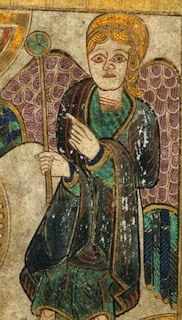 |
| Ballycotton Brooch, 8th cent. |
Back in 1875 in Ballycotton in Co. Cork, Ireland, a silver brooch was unearthed from a bog. It was dated to the eighth century AD. It was clearly a Christian cross, but what was strange about it was the inscription in the center. It was in Arabic and contained the word Allah. The rest of the inscription is unclear, it is thought either to read, "we have repented to God" or "If God wills". Either way, it is striking to consider the possibility of Arabic speaking Christians in Ireland at this time.
The evidence for oriental Christians in Ireland is fragmentary but there are several fascinating mentions of Egyptian and even Armenian Christians in Ireland from around the same time as the Ballycotton brooch.
In an early Irish litany attributed to Óengus of Tallaght (fl. 800) there is mention of seven Egyptian monks (manchaib Egipt)
buried in Uilaigh, Co. Antrim. The discovery in 2006 of an Egyptian style book binding (with papyrus lining) with the Faddan More psalter in a Tipperary bog has given support to the theory of Egyptian Christians in Ireland around the year 800.
 |
| Litany of Óengus mentioning Egyptian Monks in Ireland |
The arrival of Christians from Ummayad Spain or Egypt does open up some interesting questions relating to the character and theology of the early Irish church. Telepneff has suggested that certain Irish ascetic practices once thought to be exclusively Irish can actually be traced back to Egyptian sources. One example is the so called crux-vigilia. This ascetic practice involved praying for hours on end with your arms extended in the form of a cross. Verkerk mistakenly asserted that the cross vigil was exclusive to Irish monasticism, but as Telepneff has correctly shown the practice was followed by Egyptian monks like Pachomios as early as the fourth century.
 |
| Flabellum as depicted in the Book of Kells |
Discoveries like the Ballycotton brooch and the papyrus fragments in the Faddan More psalter have highlighted the role that oriental Christians, like the Copts, once played in the development of the early Irish church.

There is Ancient Greek on the side of St Mura’s Cross Fahan and a flabellum is depicted on the Marigold stone Carndonagh. Both in Inishowen north Donegal
ReplyDelete